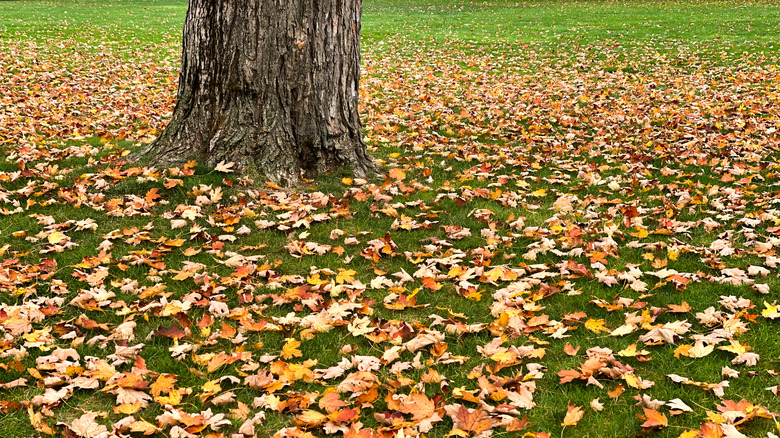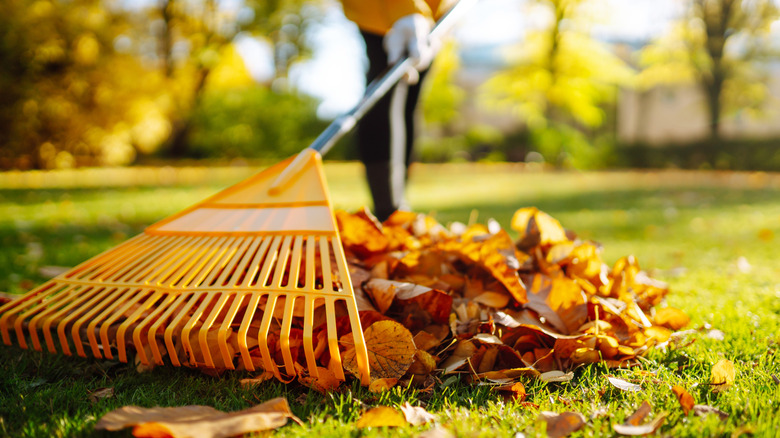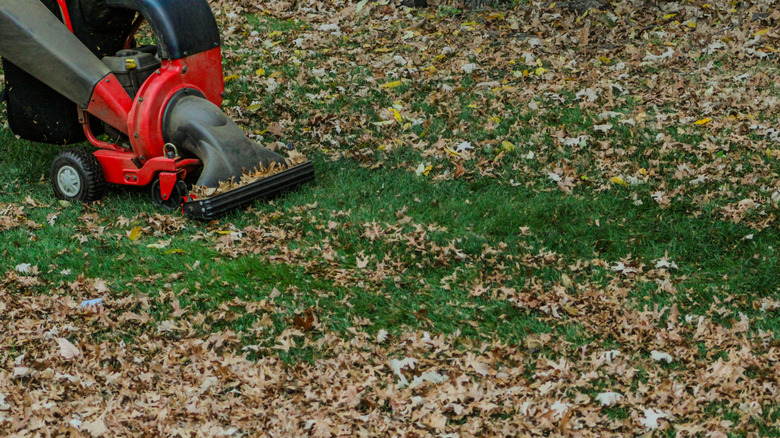How To Clear Away Leaves Without A Leaf Blower
As autumn sets in, so too does the yearly deluge of fallen leaves, signaling that there is some yard work to be done. The default tool for this task is often the leaf blower, as known for its efficiency as it is its relentless, high-decibel noise. Despite its effectiveness, the use of leaf blowers often results in annoyed neighbors. The sound these machines produce can reach up to 85 decibels, with some really powerful tools putting out over 100 decibels of sound. It's a noise level that's comparable to a motorcycle or power tool. What's worse, the sound carries for a surprising distance, disrupting the cherished quiet of weekend mornings. It's enough to make you wonder if there are any quieter leaf-removing options. The answer is yes, there are. Top alternatives include the humble rake or a leaf vacuum.
A leaf blower's drone is more than just an annoyance. It's a genuine form of noise pollution, and is why gas-powered leaf blowers are being banned all around the U.S. For neighbors, the machine's constant wail can interrupt work-from-home calls, disturb nap schedules, and ruin the enjoyment of time spent outside. Beyond the noise, gas-powered models emit exhaust fumes and kick up dirt, animal waste, and allergens like yard chemicals and mold that worsen air quality. While there are leaf-blowing tips to avoid any issues with neighbors or the law, clearing your yard of leaves does not necessitate assaulting the senses of everyone within a three-block radius. There are manual and low-noise tools that work well and preserve the tranquility of your community. You might even come to enjoy the process of seasonal cleanup.
Silence is golden: a guide to low-tech leaf-clearing tools
For homeowners who want to prioritize peace, get an essential fall chore done, and workout all at the same time, manual leaf-clearing tools are the way to go. You can neatly gather all the leaves without kicking up dust or decibels. These manual methods are an emissions-free alternative that improves the health of the user and their community. The traditional wide leaf rake remains the champion of low-tech fall leaf removal. Compared with the clunky rakes of the past, new models are ergonomic and lightweight, making lawn raking much easier. They're especially great for clearing leaves from small spaces, like delicate garden bed edging, curved retaining walls, and oddly shaped paved patios.
Need some clever tips for making raking your leaves easier? First, use a standard leaf rake to organize your leaves into tidy piles. Now, they're ready for collection, which is where specialty rakes shine. Leaf scoops or claws are essentially oversized handheld grabbers that you can use to quickly pick up lots of leaves at once, drastically cutting down time spent bending over. They pair perfectly with a leaf tarp. Look for one with reinforced handles that you move easily from leaf pile to leaf pile and carry to your compost bin or yard waste container. Lastly, make sure you have a good quality push broom. While a rake works well on grass, you need a sturdy push broom to thoroughly sweep leaves from hard surfaces like driveways, patios, and sidewalks.
Low-noise leaf-clearing machines offer a compromise
If your yard is huge or your time is limited, manual leaf-clearing won't work. Luckily, there are machine-assisted options that, unlike leaf blowers, keep noise pollution to a minimum. A lawn sweeper is worth buying. It's a fast way to tidy up a large lawn and is available in both a manual push model and one you tow behind a ride-on mower. This outdoor power tool has rotating brushes that lift leaves and small debris from your lawn and dumps them into an attached hopper. They're significantly quieter than leaf blowers and can work in small or large yards (manual machines are better for the former) with wet or dry leaves.
For a more comprehensive solution that still gets rid of that pile of leaves, consider a battery-powered or corded leaf vacuum. These machines, which run on electricity, suck up leaves then mulch them inside the collection bag. They still produce a whirring sound, but it is more eco-friendly and less noisy than that of a gas leaf blower. The benefits with a leaf vacuum are twofold: Your leaves get collected faster and are ready to compost or use on your garden as mulch, and you aren't annoying your neighbors much — or at all. Clearing up the fall leaves from your yard without using a traditional leaf blower pays dividends in a quieter, cleaner yard and happier neighbors.


